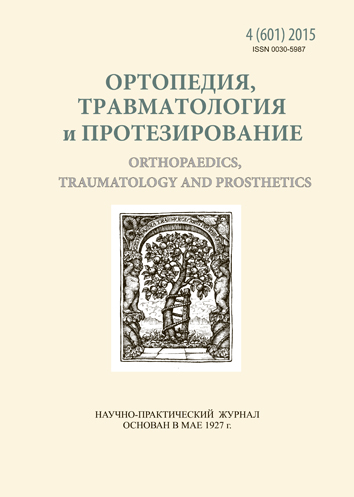The methods of treatment of long fractures and physiological fundamentals of osteosynthesis (the dynamics of views and modern state-of-art)
DOI:
https://doi.org/10.15674/0030-598720154128-133Keywords:
fractures, skeletal traction, fixing bandages, osteosynthesis, physiological principles, complications, gunshot fracturesAbstract
The spreading of AO philosophy, the traditions of native orthopedics-traumatology school and socio-economic peculiarities of the country have influenced on the tactics and technology of the treatment bone fractures in Ukraine. Simultaneously with modern AO technique skeletal traction and fixation method are used but the indications for their application are still uncertain. It was noticed many decades ago, that success of treatment is strongly correlated with early functioning of injured segment. The criteria of functionality of technology are still among the main ones to define the degree of its correspondence to the principles of physiological treatment of fractures. It was noticed, that osteosynthesis is considered as successful if it does not require any additional external fixation, allow early function and minimize negative influence on the vitality of damaged tissues. Tactical-technological items of fracture treatment require an analysis and reconsideration taking into consideration the state of orthopedics-traumatology service in Ukraine concerning the supply of high-grade licensed fixators and instruments for osteosynthesis, equipment for intraoperative radiographic monitoring and theoretical and practical training of specialists. The method of skeletal traction is still being used to treat inoperable patients and on the stages of preoperative preparation and planning. The fixing bandages and orthesises are the necessary components in complex treatment of trauma patients as the main immobilizing means and patient-specific functional orthesises to provide early functional rehabilitation. It’s emphasize, that the use of AO technology should not exclude from practice the method of external fixation that has no alternatives in the treatment of complications, open and gunshot fractures. The absence of serial production of external fixators influenced negatively on the quality of treatment of war casualties from South East part of Ukraine.References
- Guidelines of internal osteosynthesis / M. E. Muller, Algover M., R. Schneider, H. Villenegger. — Springer-Verlag: Ad Marginem, 1996. — 750 p.
- Ankin L. N. Traumatology. European standards / L. N. Ankin, Ankin N. L. — Moscow, 2005. — 438 p.
- Novachenko N. P. Constant stretching / N. P. Novachenko, F. E. Elyashberg. — K .: State. med. hub. USSR, 1960. — 240 p.
- Bochnbeimer Ph. H. Guidelines of fractures treatment / Ph. H. Bochnbeimer. — SPb .: M. I. Pirogov student medical publishing commission, 1911.
- Gelesevich A. M. Operative Surgery of troop and army district / A. M. Gelesevich. — Medgiz, 1947. — 478 p.
- Shestakova N. A. Gypsum Technology / N. A. Shestakova, A. I. Malkis. — Leningrad: Medicine, 1981. — 166 p.
- Sarmiento A. Closed functional treatment of fractures / A. Sarmiento, L. L. Latta. — Berlin, Heidelberg, New York: Springer, 1981. — 608 p.
- Stojko I. V. Mechanical properties of the "shin-fixing bandage" for fractures of the distal tibia metaepiphysis (pilon) / I. V. Stojko, I.A. Subbota, I. G. Bets // Orthopedics, Traumatology and Prosthetics . — 2014. — № 2. — P. 88–93, doi: http://dx.doi.org/10.15674/0030-59872014288-93.
- Sartan V. A. Nursing in the trauma hospital / V. A. Sartan, V. P. Ageenko, I. U. Kaem. — M .: Medicine, 1976. — 184 p.
- Namazi H. Awful considerations with LCP instrumentation: a new pitfall / H. Namazi, K. Mozaffarian // Arch. Ortoph. Trauma Surg. — 2007. — Vol. 127, № 7. — P. 573–575.
- Ganz R. Mechanical indication of bone resorption / R. Ganz, S.M. Perren, A. Ruter // Fortschr Kieber Gesichtschir. — 1975. — Vol. 19. — P. 45–48.
- Refrakturen nach operative Frakturenbehandlung. Biologishe Aspekte / S. B. Kessler, S. M. Perren, K. K. J. Hallfeldt, H. Madelrow // Hefte Unfallheikt. — 1988. — Vol. 194. — P. 13–27.
- Luthi U. K. Implants and intracortical vascular disturbances / U. K. Luthi, B. A. Rahu, S. M. Perren: abstract book of 28th Annual ORS Meeting. — 1982. — P. 337.
- AO — principles of treatment of fractures. T. 1 / T.P. Ryudi, R. E. Buckley, K. G. Moran. — Ed. 2nd, revised and add. — VASSA MEDIA, 2013. — P. 5.
- Helfet D. L. Interarticular «pilon» fractures of the tibia / D. L. Helfet, K. Koval, J. Pappas [et al.] // Clin. Orthop. — 1994. — Vol. 298. — P. 221–228.
- Korzh A. A. Integrated System of medical preventive measures in heavy open damages of limbs/ A. A. Korzh, V. Ryndenko: mat. of ΙV Union Congress of Orthopaedic Trauma. — M., 1982. — P. 33–37.
Downloads
How to Cite
Issue
Section
License
Copyright (c) 2015 Grygorii Bets, Iryna Bets

This work is licensed under a Creative Commons Attribution 4.0 International License.
The authors retain the right of authorship of their manuscript and pass the journal the right of the first publication of this article, which automatically become available from the date of publication under the terms of Creative Commons Attribution License, which allows others to freely distribute the published manuscript with mandatory linking to authors of the original research and the first publication of this one in this journal.
Authors have the right to enter into a separate supplemental agreement on the additional non-exclusive distribution of manuscript in the form in which it was published by the journal (i.e. to put work in electronic storage of an institution or publish as a part of the book) while maintaining the reference to the first publication of the manuscript in this journal.
The editorial policy of the journal allows authors and encourages manuscript accommodation online (i.e. in storage of an institution or on the personal websites) as before submission of the manuscript to the editorial office, and during its editorial processing because it contributes to productive scientific discussion and positively affects the efficiency and dynamics of the published manuscript citation (see The Effect of Open Access).














